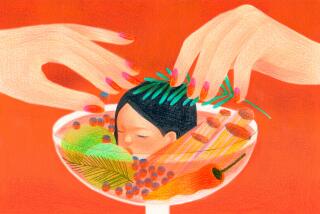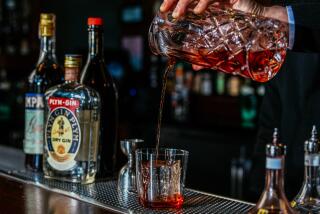SPIRITS : Single-Malt Scotches : An Informal Tasting Finds Distinctive Flavors, Bouquets and Colors
- Share via
WHEN I last wrote about Scotch whiskies, single-malt Scotches--that is, Scotches that are not blended with other whiskies--were enjoying a phenomenal rise in popularity. And they still are.
Wine and spirits shops and upscale watering holes carry as many as 50 single-malt Scotches, which is remarkable because nearly all Scotch whiskies are blends. There are 2,000 commercial blends from 110 individual distilleries, but only about 50 of these distilleries still produce single-malt whisky.
Scotch, which is any whisky made in Scotland, has been produced for centuries. As early as 1262, in the Scotch Highlands near Glenlivet and Glenfarclas, the town name of Dallasbrachti (which translates to “the Dale of the Malt House”) indicated that the art of distillation of local grains, barley and maize was well known and practiced in medieval times.
Anyone who has followed the winding roads through the Trossachs valley, with its tumbling streams and herds of cattle meandering through heather-green glens, knows that the weather there can get bitter cold as the fog descends from the mountains. During the 18th Century, cattle drivers in northern Scotland kept themselves warm with malt spirits.
Today, malt whiskies are to Scotch what chateau-bottled clarets are to regional Bordeaux. Each has its particular brilliance, color, taste, flavor and scent. Why? One may look to the romantic landscapes of the whiskies’ origins--those tumbling waters, flowing in frothy cascades down through the Highland glens.
Even the names where the distilleries once were--and still are--have a romantic air about them: Bunnahabhain, Balvenie, Glengoyne. And Gaelic corruptions from musically sounding names include Glenlivet for “Glen of the Green Grassland” and Glean-liobh-aite, meaning “Glen of the Smooth Place.”
And then there are the peat fires (the same type that dries the woolens woven into Scotland’s renowned Harris tweed) that dry the barley malt and give it a definitive smoky character that survives fermentation and distillation.
Centuries have not changed the graceful designs of the bulbous copper pot-stills with tapering tall necks bent to swan-like curves in which the whiskey is distilled to produce intense flavors.
Distilleries, like flour mills, have one thing in common: a regular, unfailing stream of pure, preferably soft water. It not only turns the mill-wheels but, also and more important, soaks the barley in the malting process. Some Scotch makers say that the secret to a good single malt is aging it in casks that have contained sherry. Finer single-malt Scotches are aged in European oak casks in which Spanish sherries have been stored. The particular type of sherry adds its own scent and taste to the whisky. For example, Fino would produce a different malt than dry Oloroso, which would give the whisky an uncompromising finesse.
To some people, all Scotches taste medicinal. But Scotch is an acquired taste, and the whiskies are good as a pre-prandial aperitif or as an after-dinner alternative to Cognac.
For this report, I sampled 14 of Southern California’s leading brands, judging them with an eye to brilliance and color, sniffing for individual bouquet, then diluting each 50% with pure water for taste evaluation, aroma and aftertaste. Here are my favorites, in order of preference:
* GLENFARCLAS 12 Years Old--Single Highland ($30.99); Malt Scotch Whisky--86 proof; 18.5 points out of a possible 20. Distilled by and bottled for J & G Grant, Glenfarclas Distillery, Speyside, Scotland. Brilliant golden amber, scents of barley, beguiling nutty taste, round, gentle. The perfection of this spirit deserves the generous bowl of a snifter glass for full appreciation, especially when it is appointed for after-dinner service.
* MACALLAN 12 Years Old--Single Highland ($25.99); Malt Scotch Whisky--86 Proof; Matured in sherry wood; 18/20. Distilled and bottled by the Macallan Distillers, Ltd., Graigellachie, Scotland. Deep amber hue, a nose of heathery peat, from Spanish dry Oloroso casks. Smooth and inviting, with a special and subtle intrigue.
* KNOCKANDO 1975 12 Years Old Fine Single ($21.95); Malt Scotch Whisky--86 proof; 17/20. Distilled and bottled in Scotland by Justerini & Brooks, Ltd., (the makers of J & B Scotch,) 61 St. James’s St., London SW1. J & B Proprietors of Knockando Distillery, Speyside. Liquid amber-bronze in color, nutty taste, sherry-wood aroma. Exciting whiskey. If J & B has been your Scotch, Knockando is a single malt to try.
* CARDHU 12 Years Old Single Malt Highland ($21.95); Scotch Whisky--80 proof; 16.5/20. Distilled and bottled in Scotland by the Cardhu Distillery, Knockando, Morayshire, Scotland. Amber-gold elegance, scents of applewood smoke in the nose. Gentle, smooth and charming.
* TALISKER 12 Years Old Unblended Single Malt ($20.99); Scotch Whisky--86.8 proof; 16/20. John Walker & Sons, Ltd., (makers of Johnnie Walker Red and Black,) Kilmarnock, Scotland. Brilliant amber-gold, sherry-cask scents, vanilla hints, nutty taste; again, charming taste from the Highlands.
* GLENLIVET 12 Years Old Single Malt ($21.99); Scotch Whisky--86 proof; 15/20. Distilled in Scotland by George & J. G. Smith, the Glenlivet Distillery, Scotland. Golden amber hue, melon, fruity hints in aroma. America’s favorite. Delicate bouquet. A refreshing spirit that is the essence of Scotland itself.

